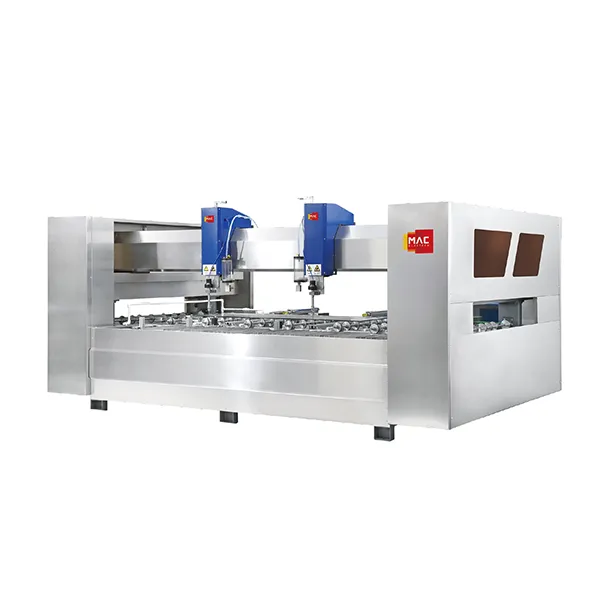Підвищення стандартів виробництва за допомогою сучасних технологій різання
У сфері сучасного виробництва зростає потреба у точності, універсальності та чистих обробках. Незалежно від того, чи йдеться про авіаційні компоненти, медичні пристрої чи індивідуальні конструкції, якість різання часто визначає успіх кінцевого продукту. Серед різних доступних методів різання водно-абразивна обробка виходить як одна з найефективніших технологій для завдань, спрямованих на досягнення максимальної точності. Здатність зберігати цілісність матеріалу при високій точності робить цю технологію найбільш вибірною в різних галузях.
Розуміння основ різання водним джетом
Холодне різання без теплової деформації
Різання водним джетом — це процес субтрактивного виробництва, який використовує воду під високим тиском, часто з абразивними частинками, для розрізання широкого діапазону матеріалів. Особливістю цього методу є його холодна природа. Оскільки тепло не утворюється під час процесу, відсутній ризик термічної деформації, утвердження або вигину. Це особливо важливо при роботі з матеріалами, чутливими до тепла, такими як гума, пластмаси та композити.
Результатом є чистий, точний зріз, який зберігає структурні властивості матеріалу. Ця якість робить різання водним джетом незамінним для виготовлення деталей, які мають відповідати суворим вимогам допусків і цілісності.
Придатний для широкого діапазону матеріалів
Однією з найсильніших переваг різання водним джетом є його сумісність з різноманітними матеріалами. Незалежно від того, чи це нержавіюча сталь, алюміній, титан, кераміка, камінь чи навіть склопакет, різання водним джетом впорається з усім цим без зусиль. Ця гнучкість зменшує потребу у кількох машинах чи зміні інструментів, економлячи час та експлуатаційні витрати.
Крім того, це технологія здатна різати матеріали товщиною від кількох міліметрів до кількох дюймів, забезпечуючи мінімальний ухил краю та відмінну якість поверхні. Така широка функціональність дозволяє виробникам оптимізувати виробничі процеси, не погіршуючи якості.
Чому різання водним джетом забезпечує вищу точність
Високі допуски для складних завданень
Точність є критичним фактором у таких галузях, як аерокосмічна, автомобільна та електронна промисловість. Різання водяним струменем забезпечує виняткову точність, зазвичай у межах ±0,1 мм або краще, залежно від обладнання та матеріалу. Це робить його ідеальним для складних геометрій, деталей із tight-tolerance та складних прототипів, де навіть незначні відхилення можуть призвести до порушення функціональності.
Порівняно з іншими методами, такими як плазмове або газове різання, різання водяним струменем забезпечує гладкіші краї з мінімальною шириною різу, що дозволяє щільніше розташовувати деталі та зменшити відходи матеріалу.
Мінімальна потреба у вторинній обробці
Оскільки різання водяним струменем залишає краї без заусенців і гладкими, це часто усуває потребу в тривалій вторинній обробці. Це скорочує як час виробництва, так і витрати на робочу силу, одночасно підвищуючи загальну ефективність. Відсутність механічного напруження також означає, що делікатні деталі залишаються недошкідленими протягом усього процесу.
Для виробників, які прагнуть оптимізувати виробництво без шкоди для якості, це є суттєвим перевагою. Це дозволяє скоротити терміни виконання проектів, зберігаючи стабільність показників продукції.
Екологічні та безпечні переваги різки водою
Відсутність небезпечних парів або теплових викидів
На відміну від лазерної або плазмової різки, різка водою не утворює токсичних парів, пилу чи надмірного шуму. Це створює безпечніші та чистіші умови праці для операторів. Особливо в галузях, де безпека на робочому місці має найвищий пріоритет, різка водою забезпечує відповідність вимогам та мінімальним ризикам.
Крім того, цей процес споживає порівняно менше енергії порівняно з деякими технологіями теплової різки, що робить його більш екологічно стійким варіантом.
Підвищена безпека операторів та мінімальний ризик
Оскільки процес не включає відкритого вогню, іскор або випромінювання, різання водною струминою забезпечує вищу безпеку у роботі. Хоча системи високого тиску потребують обережного поводження, загальний ризик отримання травм або пошкодження обладнання значно нижчий за дотримання відповідних правил безпеки.
Це робить різання водною струминою особливо придатним для майстерень та підприємств, де здійснюється обробка матеріалів різного типу або де діють суворі правила безпеки.
Як різання водною струминою підтримує сучасне виробництво
Ідеально підходить для створення прототипів та індивідуального виготовлення
У сучасному швидкоплинному ринку важливо швидко адаптуватися до нових дизайнерських рішень та вимог замовників. Різання водною струминою підтримує процес створення прототипів та малих партій продукції, оскільки дозволяє швидко змінювати матеріал і геометрію без необхідності використання дорогого оснащення чи штампів.
Конструктори та інженери можуть тестувати різні конфігурації з мінімальним часом на підготовку, що забезпечує скорочення циклів розробки продуктів та прискорення їхнього виходу на ринок.
Безшовна інтеграція з автоматизованими системами
Багато сучасних систем різання водяним струменем сумісні з програмним забезпеченням CAD/CAM та платформами роботизованої автоматизації. Це забезпечує плавний перехід від проектування до виробництва, зменшує людські помилки та максималізує продуктивність.
У середовищах масового виробництва автоматизоване різання водяним струменем забезпечує повторюваність та стабільну якість деталей на тисячах одиниць, допомагаючи виробникам відповідати як стандартам якості, так і термінам здачі.
ЧаП
Які типи матеріалів можна різати за допомогою водяного струменя?
Різання водяним струменем є дуже універсальним і може обробляти метали, скло, кераміку, камінь, гуму, пінопласт, пластмаси та композити. Воно особливо добре працює з матеріалами, чутливими до тепла.
Наскільки точне різання водяним струменем порівняно з іншими методами?
Різання водяним струменем може досягати допусків до ±0,1 мм, часто перевершуючи плазмове та газове різання за точністю та якістю краю. Воно також мінімізує потребу в додаткових процесах остаточної обробки.
Чи є різання водяним струменем екологічно безпечним?
Так. Різка водою не виробляє шкідливих парів або теплових викидів, і вона споживає менше енергії порівняно з багатьма традиційними методами різки. Воду, яку використовують у процесі, часто можна переробляти.
Чи є вона економічно вигідною для малих серій виробництва?
Однозначно. Для різки водою не потрібне спеціальне обладнання, що робить її ідеальною для коротких серій, замовних робіт і створення прототипів. Мінімальні витрати часу на підготовку та висока точність забезпечують загальну економію коштів.
 EN
EN
 AR
AR
 BG
BG
 HR
HR
 CS
CS
 DA
DA
 NL
NL
 FI
FI
 FR
FR
 DE
DE
 EL
EL
 HI
HI
 IT
IT
 JA
JA
 KO
KO
 PL
PL
 PT
PT
 RO
RO
 RU
RU
 ES
ES
 SV
SV
 TL
TL
 IW
IW
 LV
LV
 LT
LT
 SK
SK
 SL
SL
 UK
UK
 VI
VI
 ET
ET
 HU
HU
 MT
MT
 TH
TH
 TR
TR
 FA
FA
 MS
MS
 SW
SW
 GA
GA
 AZ
AZ
